Dissection of Year Related Climatic Variables and Their Effect on Winter Rapeseed (Brassica Napus L.) Development and Yield
Abstract
1. Introduction
2. Materials and Methods
2.1. Trial Design and Plant Material
2.2. Calculation of Climatic Variables
2.3. Statistical Analysis
3. Results
3.1. Weather Conditions
3.2. Variability of Seed Yield and Oil Content
3.3. Cultivar Performance and the Effect of Year
3.4. The Effect of Climatic Variables on the Year-Related Interactions
4. Discussion
4.1. Sources of Variability for Seed Yield and Oil Content
4.2. Time of Sowing, N Rates and Growing Seasons
4.3. The Effect of Climatic Variables on the Year Related Interactions
4.4. Cultivar Main Effect in Comparison to Interactions
Supplementary Materials
Author Contributions
Funding
Conflicts of Interest
References
- FAOSTAT. FAOSTAT Data. 2016. Available online: www.faostat.fao.org (accessed on 14 March 2018).
- Friedt, W.; Snowdon, R. Oilseed rape. In Oil Crops; Vollmann, J., Rajcan, I., Eds.; Springer: New York, NY, USA, 2009; pp. 91–126. [Google Scholar]
- Salunkhe, D.K.; Chavan, J.K.; Adsule, R.N.; Kadam, S.S. Sunflower. In World Oilseeds, Chemistry, Technology and Utilization; Salunkhe, D.K., Chavan, J.K., Adsule, R.N., Kadam, S.S., Eds.; Van Nostrand Reinhold: New York, NY, USA, 1992; pp. 97–139. [Google Scholar]
- Rodrigues, I.M.; Coelho, J.; Graça, M.; Carvalho, V.S. Isolation and valorization of vegetable proteins from oilseed plants: Methods, limitations and potential. J. Food Eng. 2012, 109, 337–346. [Google Scholar] [CrossRef]
- Takashima, N.E.; Rondanini, D.P.; Puhl, L.E.; Miralles, D.L. Environmental factors affecting yield variability in spring and winter rapeseed genotypes cultivated in the southeastern Argentine Pampas. Eur. J. Agron. 2013, 48, 88–100. [Google Scholar] [CrossRef]
- Turinek, M.; Bavec, M.; Repič, M.; Turinek, M.; Urbanek-Krajnc, A.; Möllers, C.; Tres, A.; Bavec, F. Effects of intensive and alternative production systems on the technological and quality parameters of rapeseed seed (Brassica napus L. ‘Siska’). J. Sci. Food Agric. 2017, 97, 2647–2656. [Google Scholar] [CrossRef]
- Sidlauskas, G.; Bernotas, S. Some factors affecting seed yield of spring rapeseed (Brassica napus L.). Agron. Res. 2003, 1, 229–243. [Google Scholar]
- Zhao, J.; Becker, H.C.; Zhang, D.; Zhang, Y.; Ecke, W. Oil content in a European x Chinese rapeseed population QTL with additive and epistatic effects and their cultivar x environment interaction. Crop. Sci. 2005, 45, 51–59. [Google Scholar]
- Marjanović-Jeromela, A.; Nagl, N.; Gvozdanović-Varga, J.; Hristov, N.; Kondić-Špika, A.; Vasić, M.; Marinković, R. Genotype by environment interaction for seed yield per plant in rapeseed using AMMI model. Pesqui. Agropecu. Bras. 2011, 46, 174–181. [Google Scholar] [CrossRef]
- Marjanović-Jeromela, A.; Terzić, S.; Zorić, M.; Marinković, R.; Atlagić, J.; Mitrović, P.; Milovac, Ž. Evaluation of seed and oil yield stability in NS rapeseed cultivars (Brassica napus L.). Field Veg. Crops Res. 2011, 48, 67–76. [Google Scholar] [CrossRef]
- Hoffmann, M.P.; Jacobs, A.; Whitbread, A.M. Crop modeling based analysis of site-specific production limitations of winter oilseed rape in northern Germany. Field Crops Res. 2015, 178, 49–62. [Google Scholar] [CrossRef]
- Nanda, R.; Bhargava, S.C.; Tomar, D.P.S.; Rawson, H.M. Phenological development of Brassica campestris, Brassica juncea, Brassica napus and Brassica carinata grown in controlled environments and from 14 sowing dates in the field. Field Crops Res. 1996, 46, 93–103. [Google Scholar] [CrossRef]
- Ehrensing, D.T. Canola. Oregon State University Extension Services-EM 8955-E. 2008. Available online: https://catalog.extension.oregonstate.edu/em8955 (accessed on 26 September 2017).
- Department of Agriculture Forestry and Fisheries (DAFF). Canola Production Guideline 2; Department of Agriculture Forestry and Fisheries (DAFF): Pretoria, South Africa, 2010.
- Yang, C.; Gan, Y.; Harker, K.N.; Kutcher, H.R.; Gulden, R.; Irvine, B.; May, W.E. Up to 32% yield increase with optimized spatial patterns of canola plant establishment in western Canada. Agron. Sustain. Dev. 2014, 34, 793–801. [Google Scholar] [CrossRef]
- Böttcher, U.; Rampin, E.; Hartmann, K.; Zanetti, F.; Flenet, F.; Morison, M.; Kage, H. A phenological model of winter oilseed rape according to the BBCH scale. Crop. Pasture Sci. 2016, 67, 345–358. [Google Scholar] [CrossRef]
- Colnenne, C.; Meynard, J.M.; Reau, R.; Justes, E.; Merrien, A. Determination of a critical dilution curve for winter oilseed rape. Ann. Bot. 1998, 81, 311–317. [Google Scholar] [CrossRef]
- Sierts, H.P.; Geisler, G.; Leon, J.; Diepenbrock, W. Stability of yield components from winter oil-seed rape (Brassica napus L.). J. Agron. Crop. Sci. 1987, 158, 107–113. [Google Scholar] [CrossRef]
- Deligios, P.A.; Farci, R.; Sulas, L.; Hoogenboom, G.; Ledda, L. Predicting growth and yield of winter rapeseed in a Mediterranean environment: Model adaptation at a field scale. Field Crops Res. 2013, 144, 100–112. [Google Scholar] [CrossRef]
- Gabrielle, B.; Denoroy, P.; Gosse, G.; Justes, E.; Andersen, M.N. A model of leaf area development and senescence of winter oilseed rape. Field Crops Res. 1998, 57, 209–222. [Google Scholar] [CrossRef]
- Robelin, M.; Triboi, A.M. Assimilation netted’une culture de colza d’hiver au cours du cycle de vegetation sous l’influence de l’environment climatique de la densite du peuplementet de la fertilization azotee. In Proceedings of the 6th International Rapeseed Conference, Paris, France, 17–19 May 1983; pp. 98–103. [Google Scholar]
- Lardon, A.; Triboi-Blondel, A.M. Cold and freeze stress at flowering—Effects on seed yield in winter rapeseed. Field Crops Res. 1995, 44, 95–101. [Google Scholar] [CrossRef]
- Balodis, O.; Gaile, Z. Sowing date and rate effect on winter oilseed rape (Brassica napus L.) yield components’ formation. Proc. Latv. Acad. Sci. Sect. B 2016, 70, 384–392. [Google Scholar] [CrossRef]
- Weymann, W.; Böttcher, U.; Sieling, K.; Kage, H. Effects of weather conditions during different growth phases on yield formation of winter oilseed rape. Field Crops Res. 2015, 173, 41–48. [Google Scholar] [CrossRef]
- Richards, R.A.; Thurling, N. Variation between and within species of rapeseed (Brassica campestris and B. napus) in response to drought stress. I. Sensitivity at different stages of development. Aust. J. Agric. Res. 1978, 29, 469–477. [Google Scholar] [CrossRef]
- Kuo, N.C.; Chen, C.; Cheng, H.H. The effect of different temperatures on agronomic characters, seed yield, oil content and fatty acid composition of rapeseed. Mem. Coll. Agric. Natl. Taiwan Univ. 1980, 20, 45–53. [Google Scholar]
- Hocking, P.J.; Stapper, M. Effects of sowing time and nitrogen fertiliser on canola and wheat, and nitrogen fertiliser on Indian mustard. II. Nitrogen concentrations, N accumulation, and N fertiliser use efficiency. Aust. J. Agric. Res. 2001, 52, 635–644. [Google Scholar] [CrossRef]
- Tesfamariam, E.H.; Annandale, J.G.; Steyn, J.M. Water stress effects on winter canola growth and yield. Agron. J. 2010, 102, 658–666. [Google Scholar] [CrossRef]
- Berry, P.M.; Spink, J.H. A physiological analysis of oilseed rape yields: Past and future. J. Agric. Sci. 2006, 144, 381–392. [Google Scholar] [CrossRef]
- Gerbens-Leenes, W.; Hoekstra, A.Y.; van der Meer, T.H. The water footprint of bioenergy. Proc. Natl. Acad. Sci. USA 2009, 106, 10219–10223. [Google Scholar] [CrossRef]
- Zanetti, F.; Rampin, E.; Loddo, S.; Vamerali, T.; Mosca, G. Root morphology and nitrogen efficiency in new hybrids of winter rape. In Proceedings of the 13th International Rapeseed Congress, Prague, Czech Republic, 5–8 June 2011; pp. 287–290. [Google Scholar]
- Henke, J.; Böttcher, U.; Neukam, D.; Sieling, K.; Kage, H. Evaluation of different agronomic strategies to reduce nitrate leaching after winter oilseed rape (Brassica napus L.) using a simulation model. Nutr. Cycl. Agroecosyst. 2008, 82, 299–314. [Google Scholar] [CrossRef]
- Becker, F.A.; Lange, V. Standortvergleich zur N-Frühjahrsdüngung des Wintergetreides nach der Nmin-Methode. Z. Acker Pflanzenbau 1982, 151, 459–472. [Google Scholar]
- Wehrmann, J.; Scharpf, H.C. The Nmin method—An aid to integrating various objectives of nitrogen fertilization. Z. Pflanz. Bodenk. 1986, 149, 428–440. [Google Scholar] [CrossRef]
- Harper, F.R.; Berkenkamp, B. Revised growth-stage key for Brassica campestris and B. napus. Can. J. Plant Sci. 1975, 55, 657–658. [Google Scholar] [CrossRef]
- Lancashire, P.D.; Bleiholder, H.; Van Den Boom, T.; Langeluddeke, P.; Stauss, S.; Weber, E.; Witzenberger, A. A uniform decimal code for growth stages of crops and weeds. Ann. App. Biol. 1991, 119, 561–601. [Google Scholar] [CrossRef]
- Granlund, M.; Zimmerman, D.C. Effect of drying conditions on oil content of sunflower (Helianthus annuus L.) seeds as determined by wide-line nuclear magnetic resonance (NMR). Proc. North. Dak. Acad. Sci. 1975, 27, 128–132. [Google Scholar]
- Butler, D.G.; Cullis, B.R.; Gilmour, A.R.; Gogel, B.J. Analysis of Mixed Models for S language Environments: Asreml-R Reference Manual; Queensland DPI: Brisbane, Queensland, 2010. [Google Scholar]
- Brien, C.J. AsremlPlus: A Collection of Functions to Augment the Use of Asreml in Fitting Mixed Models. Available online: http://cran.at.r-project.org/web/packages/asremlPlus/index.html (accessed on 5 September 2019).
- Snedecor, G.W.; Cochran, W.G. Statistical Methods, 8th ed.; Iowa State University Press: Ames, IA, USA, 1989; p. 503. [Google Scholar]
- Welham, S.J.; Cullis, B.R.; Gogel, B.J.; Gilmour, A.R.; Thompson, R. Prediction in linear mixed models. Aust. N. Z. J. Stat. 2004, 325–347. [Google Scholar] [CrossRef]
- Butler, D.G.; Cullis, B.R.; Gilmour, A.R.; Gogel, B.J. ASReml-R Reference Manual, Release 3; Technical Report; Queensland Department of Primary Industries: Brisbane, Australia, 2009. [Google Scholar]
- Van Eeuwijk, F.A.; Denis, J.B.; Kang, M.S. Incorporating additional information on genotypes and environments in models for two-way genotype by environment tables. In Genotype by Environment Interaction; Kang, M.S., Gauch, Z., Eds.; CRC Press: Boca Raton, FL, USA, 1996; pp. 15–50. [Google Scholar]
- Voltas, J.; López-Córcoles, H.; Borrás, G. Use of biplot analysis and factorial regression for the investigation of superior genotypes in multi-environment trials. Eur. J. Agron. 2005, 22, 309–324. [Google Scholar] [CrossRef]
- Yan, W.; Rajcan, I. Biplot analysis of test sites and trait relations of soybean in Ontario. Crop. Sci. 2002, 42, 11–20. [Google Scholar] [CrossRef]
- Andrade, F.H.; Abbate, P.E.; Otegu, M.E.; Cirilo, A.G.; Cerrudo, A.A. Ecophysiological bases for crop management. Am. J. Plant Sci. 2010, 4, 23–34. [Google Scholar]
- Wang, S.; Wang, E.; Wang, F.; Tang, L. Phenological development and grain yield of canola as affected by sowing date and climate variation in the Yangtze River Basin of China. Crop. Pasture Sci. 2012, 63, 478–488. [Google Scholar] [CrossRef]
- Turhan, H.; Gul, M.K.; Egesel, C.O.; Kahriman, F. Effect of sowing date on grain yield, oil content, and fatty acids in rapeseed (Brassica napus subsp. oleifera). Turk. J. Agric. For. 2011, 35, 225–234. [Google Scholar]
- Balalić, I.; Marjanović-Jeromela, A.; Crnobarac, J.; Terzić, S.; Radić, V.; Miklič, V.; Jovičić, D. Effect of seeding date on oil and protein content in winter rapeseed cultivars. In Proceedings of the 14th International Consultative Group for Research on Rapeseed (GCIRC) and Ag-West Bio, Saskatoon, SK, Canada, 5–9 July 2015; p. 446. [Google Scholar]
- Crnobarac, J.; Marinković, B.; Marjanović-Jeromela, A.; Balalić, I.; Jaćimović, G.; Latković, D. The effect of variety, fertilization and sowing date on overwintering of oilseed rape. In Proceedings of the 14th International Consultative Group for Research on Rapeseed (GCIRC) and Ag-West Bio, Saskatoon, SK, Canada, 5–9 July 2015; p. 455. [Google Scholar]
- Shah, S.A.; Rahman, K. Yield and growth response of rapeseed (Brassica napus L.) mutants to different seeding rates and sowing dates. Pak. J. Bot. 2009, 41, 2711–2716. [Google Scholar]
- Ozer, H. Sowing date and nitrogen rate effects on growth, yield and yield components of two summer rapeseed cultivars. Eur. J. Agron. 2003, 19, 453–463. [Google Scholar] [CrossRef]
- Sieling, K.; Böttcher, U.; Kage, H. Effect of Sowing Method and N Application on Seed Yield and N Use Efficiency of Winter Oilseed Rape. Agronomy 2017, 7, 21. [Google Scholar] [CrossRef]
- Taheri, E.; Soleymani, A.; Javanmard, H.R. The effect of different nitrogen levels on oil yield and harvest index of two spring rapeseed cultivars in Isfahan region. Int. J. Agric. Crop. Sci. 2012, 4, 1496–1498. [Google Scholar]
- Aminpanah, H. Effect of nitrogen rate on seed yield, protein and oil content of two canola (Brassica napus L.) cultivars. Acta Agric. Slov. 2013, 101, 183–190. [Google Scholar] [CrossRef]
- Cheema, M.A.; Malik, M.A.; Hussain, A.; Shah, S.H.; Basra, S.M.A. Effects of time and rate of nitrogen and phosphorus application on the growth and the seed and oil yields of canola (Brassica napus L.). J. Agron. Crop. Sci. 2001, 186, 103–110. [Google Scholar] [CrossRef]
- Hocking, P.J.; Randall, P.J.; Demarco, D. The response of dryland canola to nitrogen fertilizer: Partitioning and mobilization of dry matter and nitrogen, and nitrogen effects on yield components. Field Crops Res. 1997, 54, 201–220. [Google Scholar] [CrossRef]
- Rathke, G.W.; Christen, O.; Diepenbrock, W. Effects of nitrogen source and rate on productivity and quality of winter oilseed rape (Brassica napus L.) grown in different crop rotations. Field Crops Res. 2005, 94, 103–113. [Google Scholar] [CrossRef]
- Ozturk, O. Effects of source and rate of nitrogen fertilizer on yield, yield components and quality of winter rapeseed (Brassica napus L.). Chil. J. Agric. Res. 2010, 70, 132–141. [Google Scholar] [CrossRef]
- Vujaković, M.; Marjanović-Jeromela, A.; Jovičić, D.; Lečić, N.; Marinković, R.; Jakovljević, N.; Mehandžić-Stanišić, S. Effect of plant density on seed quality and yield of oilseed rape (Brassica napus L.). J. Process. Energy Agric. 2014, 18, 73–76. [Google Scholar]
- Kennedy, Y.; Yokoi, S.; Sato, T.; Daimon, H.; Nishida, I.; Takahata, Y. Genetic variation of storage compounds and seed weight in rapeseed (Brassica napus L.) germplasms. Breed. Sci. 2011, 61, 311–315. [Google Scholar] [CrossRef][Green Version]
- Kuht, J.; Torra, T.; Kilgi, J. Effect of site-based fertilization on spring oilseed rape yield and seed quality. J. Agric. Sci. 2015, 1, 16–23. [Google Scholar]
- Velička, R.; Pupalienė, R.; Butkevičienė, L.M.; Kriaučiūnienė, Z. Peculiarities of overwintering of hybrid and conventional cultivars of winter rapeseed on the sowing date. Acta Sci. Pol. Agric. 2012, 11, 53–66. [Google Scholar]
- Zhang, H.; Berger, J.D.; Milroy, S.P. Genotype x environment interaction studies highlight the role of phenology in specific adaptation of canola (Brassica napus L.) to contrasting Mediterranean climates. Field Crops Res. 2013, 144, 77–88. [Google Scholar] [CrossRef]
- Guo, Y.; Hans, H.; Christian, J.; Molina, C. Mutations in single FT- and TFL1-paralogs of rapeseed (Brassica napus L.) and their impact on flowering time and yield components. Front. Plant Sci. 2014, 5, 282. [Google Scholar] [CrossRef]
- Schiessl, S.V.; Qian, W.; Iniguez-Luy, F.; Snowdon, R.J. Diverse regulatory factors associate with flowering time and yield responses in winter-type Brassica napus. BMC Genom. 2015, 16, 737. [Google Scholar] [CrossRef]
- Moghaddam, M.J.; Pourdad, S.S. Cultivar x environment interactions and simultaneous selection for high oil yield and stability in rainfed warm areas rapeseed (Brassica napus L.) from Iran. Euphytica 2011, 180, 321–335. [Google Scholar] [CrossRef]
- Ni, Z.; Kim, E.D.; Ha, M.; Lackey, E.; Liu, J.; Zhang, Y.; Sun, Q.; Chen, Z.J. Altered circadian rhythms regulate growth vigour in hybrids and allopolyploids. Nature 2009, 457, 327–331. [Google Scholar] [CrossRef]
- Jung, C.; Müller, A.E. Flowering time control and applications in plant breeding. Trends Plant Sci. 2009, 14, 563–573. [Google Scholar] [CrossRef]
- Greenland, D. Climate variability and sugarcane yield in Louisiana. J. Appl. Meteorol. 2005, 44, 1655–1666. [Google Scholar] [CrossRef]
- Cullis, B.R.; Smith, A.B.; Beeck, C.P.; Cowling, W.A. Analysis of yield and oil from a series of canola breeding trials. Part I. Fitting factor analytic mixed models with pedigree information. Genome 2010, 53, 992–1001. [Google Scholar]
- Miri, Y.; Bagheri, H. Evaluation planting date on agronomical traits of canola (Brassica napus L.). Int. Res. J. Appl. Basic Sci. 2013, 4, 601–603. [Google Scholar]
- Gomez, N.V.; Miralles, D.J. Factors that modify early and late reproductive phases in oilseed rape (Brassica napus L.): Its impact on seed yield and oil content. Ind. Crops Prod. 2011, 34, 1277–1285. [Google Scholar] [CrossRef]
- Walton, G.; Si, P.; Bowden, B. Environmental Impact on Canola Yield and Oil. In Proceedings of the 10th International Canola Congress, Canberra, Australia, 26–29 September 1999; p. 136. [Google Scholar]
- Faraji, A. Oil concentration in canola (Brassica napus L.) as a function of environmental conditions during seed filling period. Int. J. Plant Prod. 2012, 6, 267–278. [Google Scholar]
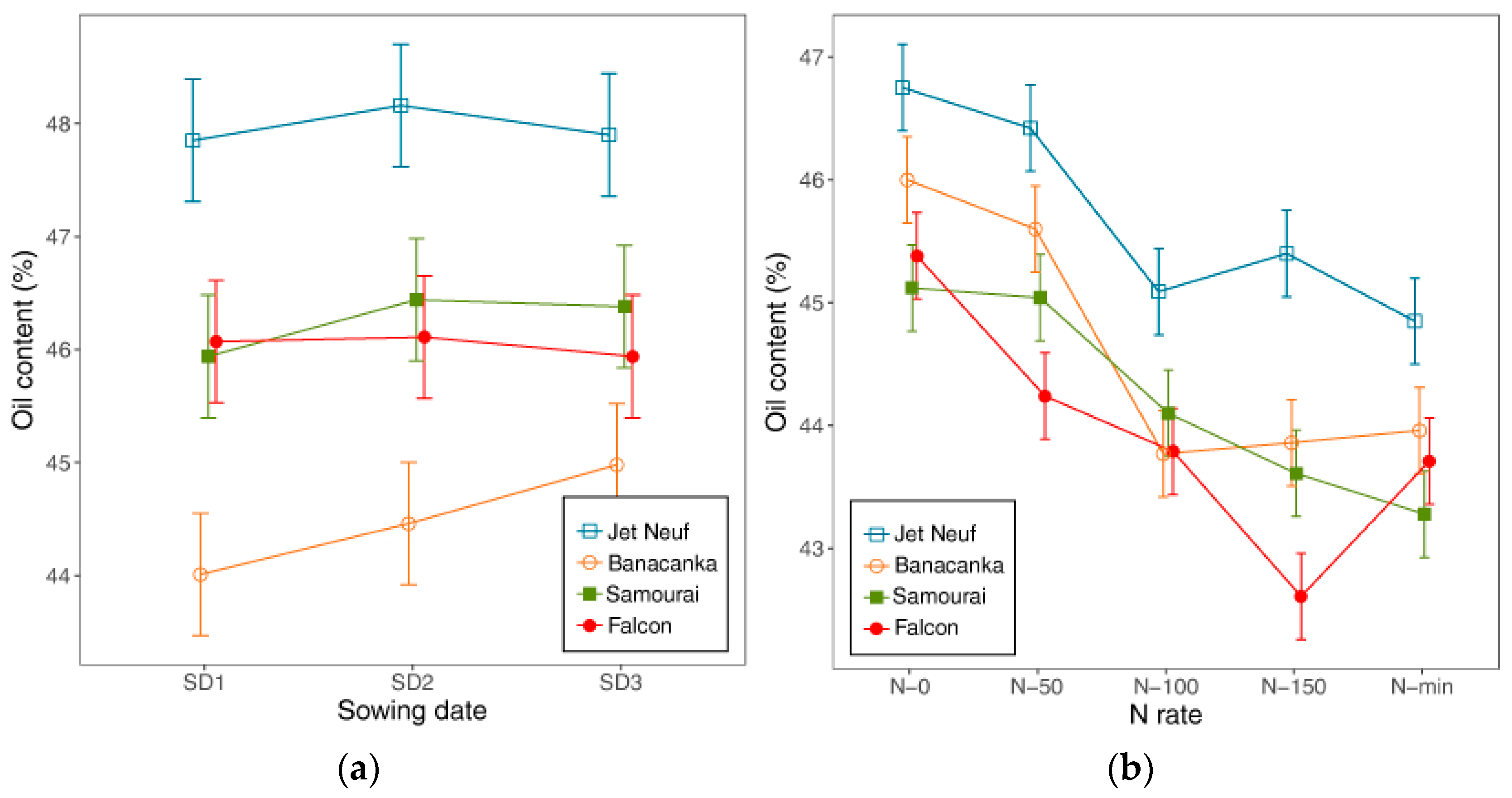
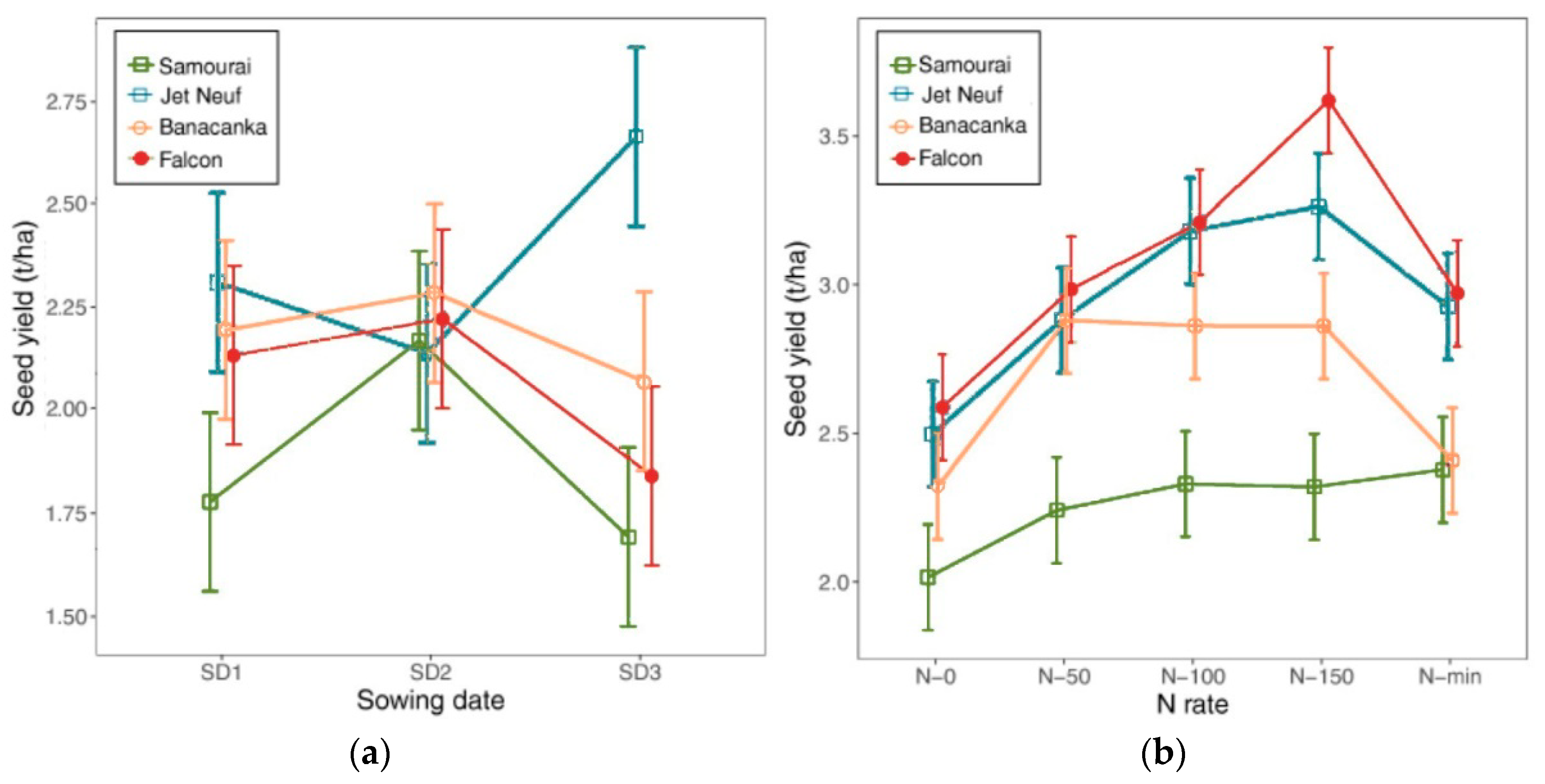
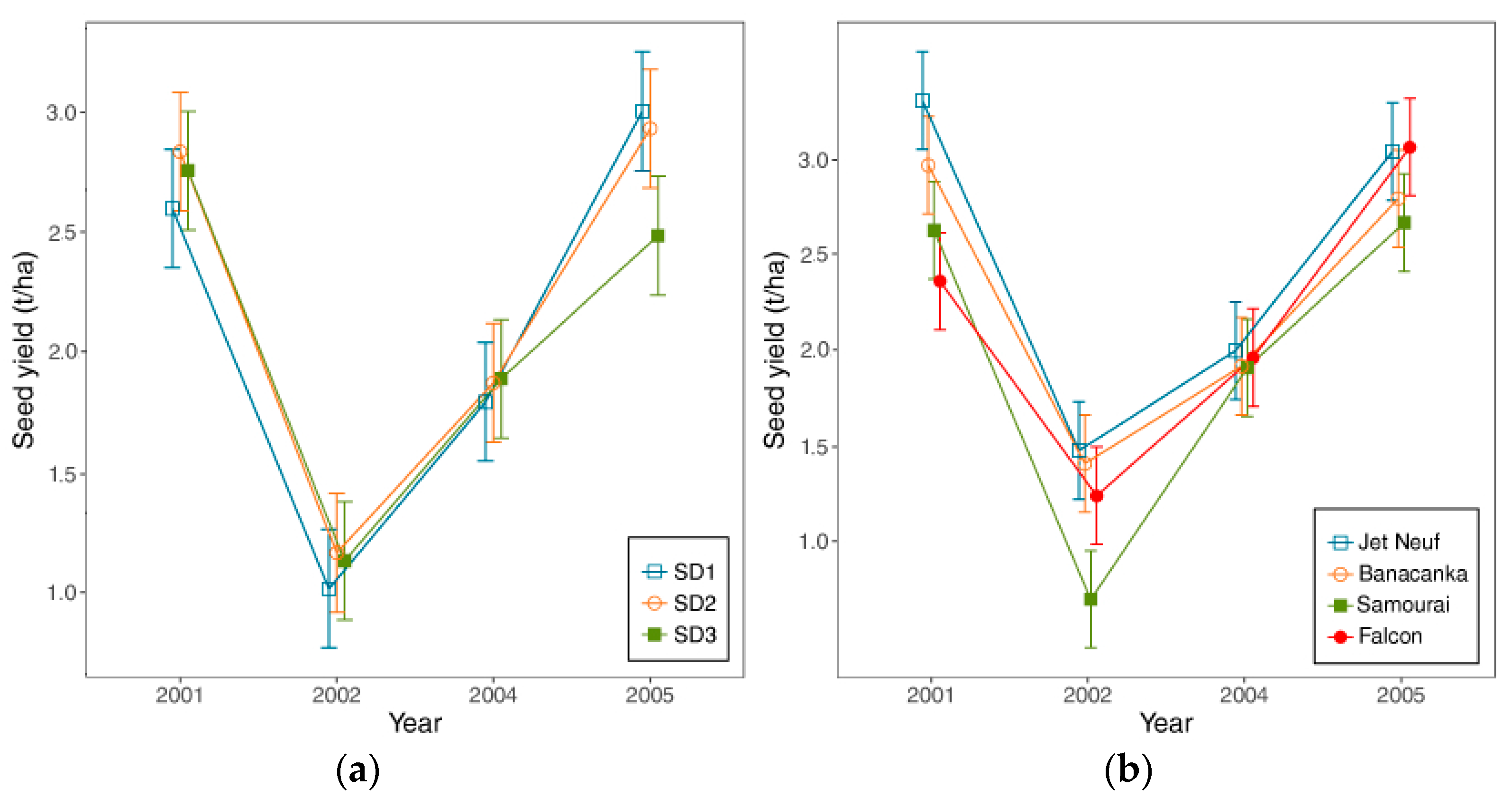

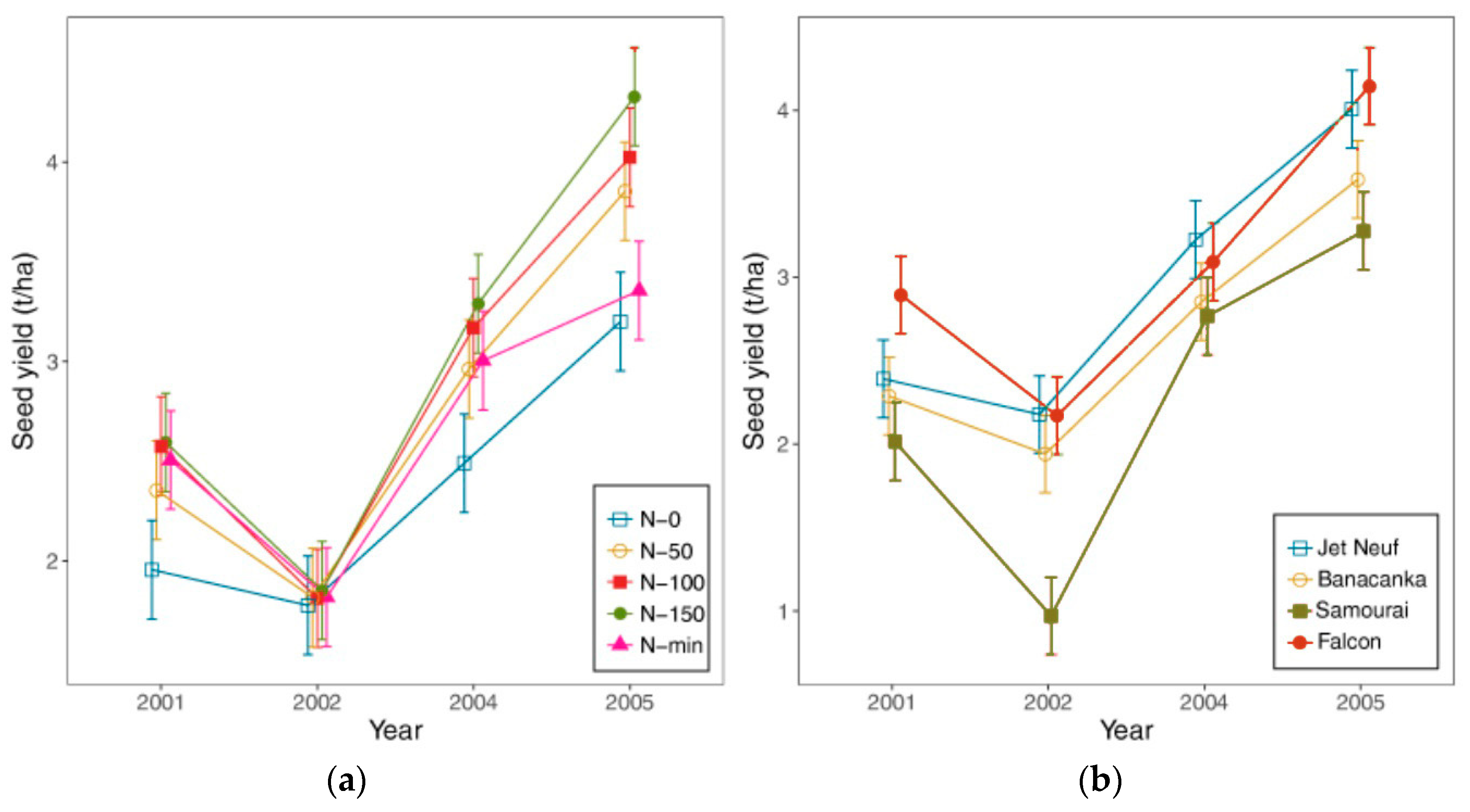
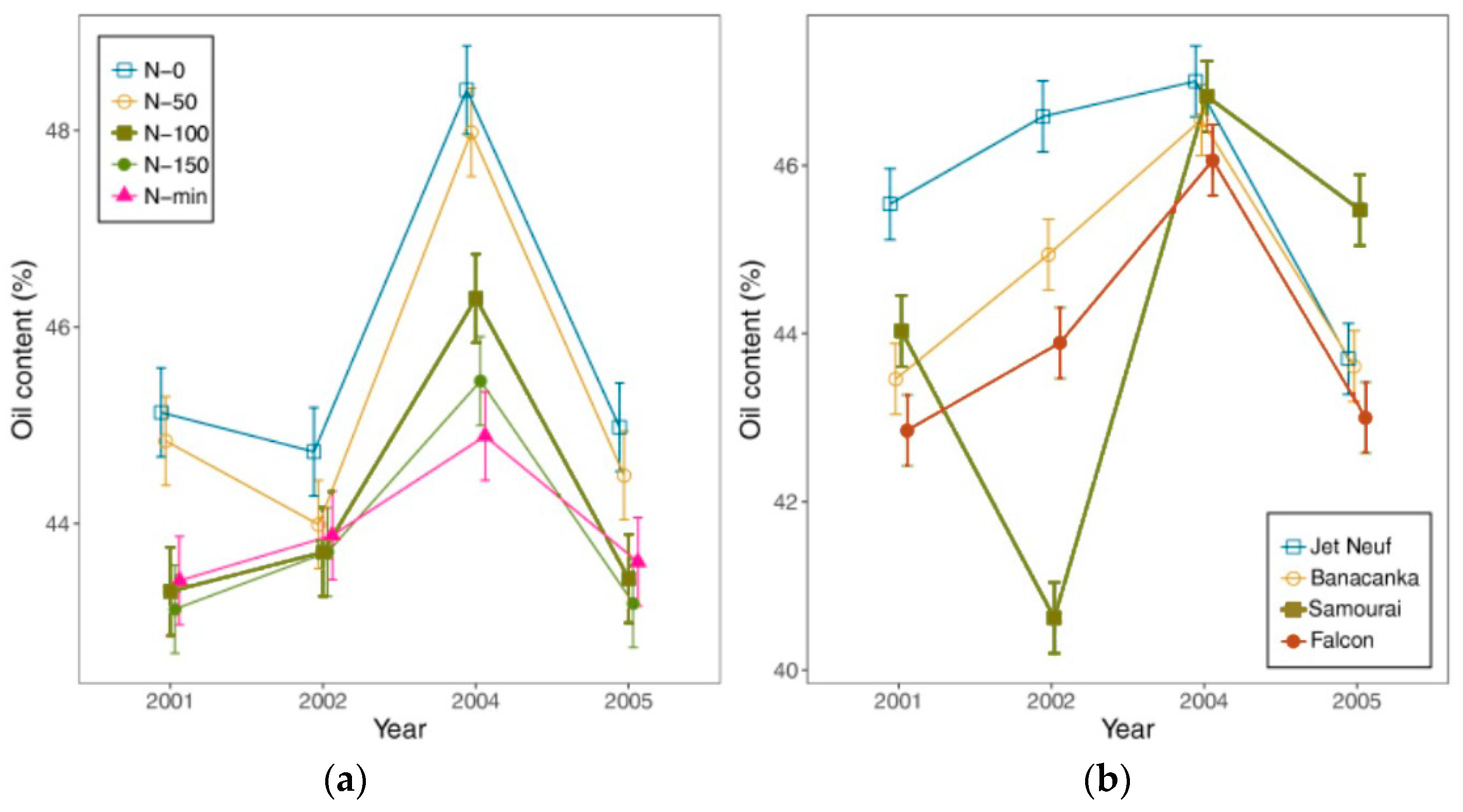


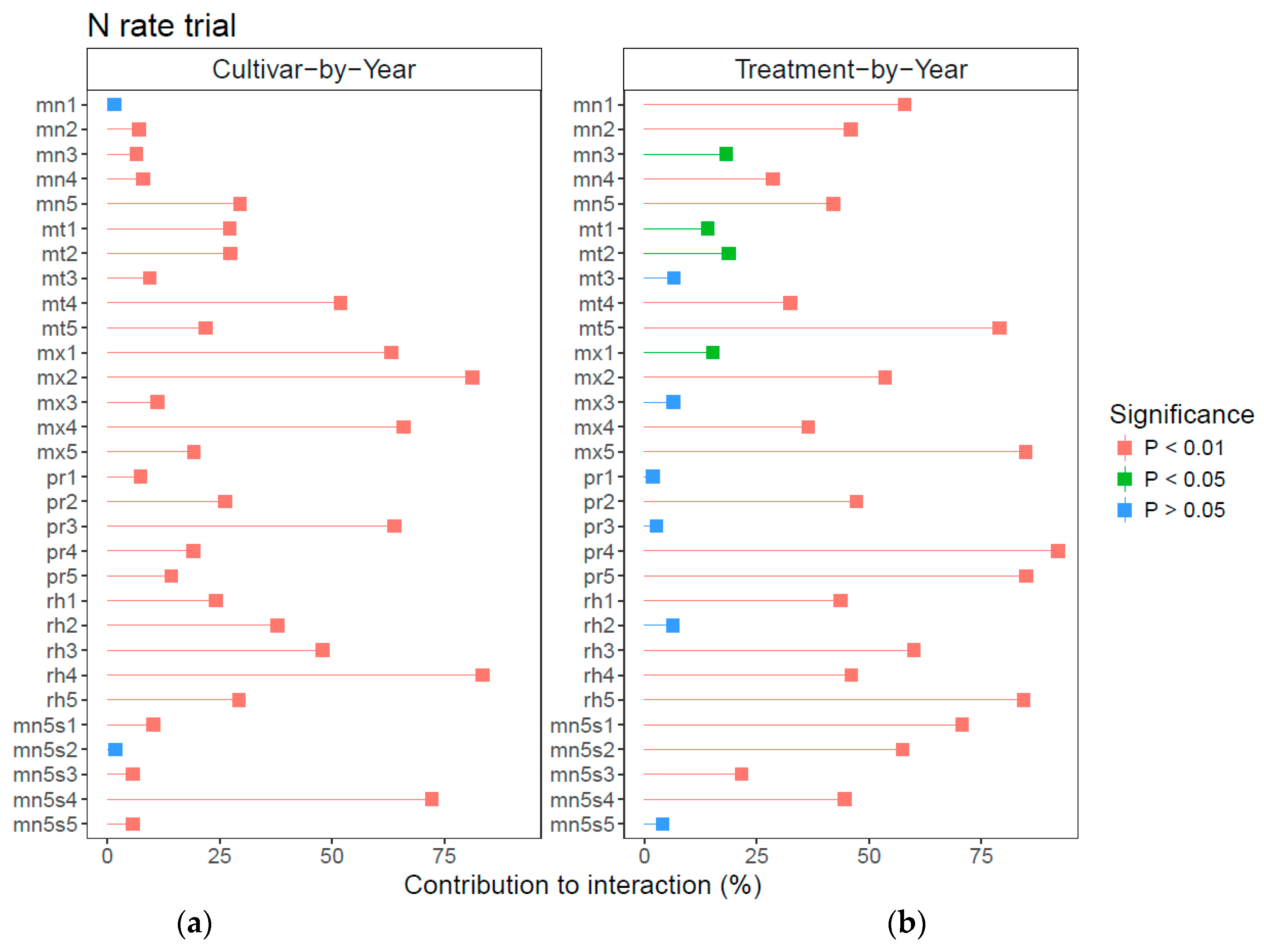
| Vegetative and Reproductive Stages | 2001/02 | 2002/03 | 2004/05 | 2005/06 | ||||||||
|---|---|---|---|---|---|---|---|---|---|---|---|---|
| SD1 | SD2 | SD3 | SD1 | SD2 | SD3 | SD1 | SD2 | SD3 | SD1 | SD2 | SD3 | |
| GS 0 Germination | 25.8.01 * | 5.9.01 | 14.9.01 | 21.8.02 | 30.8.02 | 9.9.02 | 1.9.04 | 10.9.04 | 20.9.04 | 5.9.05 | 15.9.05 | 26.9.05 |
| GS1+2 Seedling and rosette | 12.9.01 | 23.9.01 | 30.9.01 | 1.10.02 | 29.9.02 | 4.10.02 | 27.9.04 | 4.10.04 | 4.10.04 | 24.9.05 | 25.9.05 | 5.10.05 |
| GS3 Budding | 30.3.02 | 30.3.02 | 1.4.02 | 19.4.03 | 19.4.03 | 20.4.03 | 13.4.05 | 14.4.05 | 14.4.05 | 12.4.06 | 11.4.06 | 13.4.06 |
| GS4 Flowering | 8.4.02 | 8.4.02 | 10.4.02 | 25.4.03 | 25.4.03 | 26.4.03 | 23.4.05 | 23.4.05 | 23.4.05 | 21.4.06 | 20.4.06 | 22.4.06 |
| GS5 Ripening | 6.5.02 | 7.5.02 | 7.5.02 | 12.5.03 | 12.5.03 | 13.5.03 | 19.5.05 | 19.5.05 | 19.5.05 | 9.5.06 | 9.5.06 | 12.5.06 |
| Harvest | 26.6.02 | 28.6.02 | 30.6.02 | 20.6.03 | 23.6.03 | 24.6.03 | 2.7.05 | 4.7.05 | 4.7.05 | 1.7.06 | 1.7.06 | 2.7.06 |
| Air temperature < 5 °C | 5.11.01–14.2.02 | 7.11.02–12.3.03 | 15.11.04–18.3.05 | 5.11.05–24.3.06 | ||||||||
| Climatic Factor | Climatic Variable | 2001/02 | 2002/03 | 2004/05 | 2005/06 | ||||||||
|---|---|---|---|---|---|---|---|---|---|---|---|---|---|
| SD1 | SD2 | SD3 | SD1 | SD2 | SD3 | SD1 | SD2 | SD3 | SD1 | SD2 | SD3 | ||
| Mean temperature (°C) | mt1 | 16.9 | 14.3 | 15.2 | 17.6 | 16.8 | 14.5 | 16.2 | 14.7 | 13.7 | 17.4 | 15.3 | 14.6 |
| mt2 | 5.9 | 5.4 | 5.0 | 4.2 | 4.2 | 4.1 | 4.6 | 4.3 | 4.3 | 4.9 | 4.8 | 4.3 | |
| mt3 | 8.4 | 8.4 | 7.9 | 12.7 | 12.7 | 13.4 | 11.6 | 11.6 | 11.6 | 12.4 | 12.2 | 13.0 | |
| mt4 | 13.4 | 13.5 | 14.0 | 21.2 | 21.2 | 21.8 | 14.6 | 14.6 | 14.6 | 14.6 | 14.4 | 14.5 | |
| mt5 | 20.6 | 20.7 | 20.7 | 22.0 | 22.1 | 22.2 | 19.6 | 19.6 | 19.6 | 18.8 | 18.8 | 19.2 | |
| Precipitation (mm) | pr1 | 118 | 148 | 42 | 55 | 46 | 52 | 48 | 43 | 38 | 56 | 47 | 15 |
| pr2 | 217 | 163 | 160 | 241 | 244 | 234 | 387 | 381 | 381 | 296 | 276 | 287 | |
| pr3 | 0 | 0 | 2 | 2 | 2 | 3 | 15 | 11 | 11 | 40 | 40 | 21 | |
| pr4 | 35 | 35 | 35 | 3 | 3 | 3 | 52 | 52 | 52 | 16 | 17 | 28 | |
| pr5 | 101 | 97 | 107 | 34 | 37 | 37 | 168 | 192 | 192 | 163 | 163 | 157 | |
| Plant Density | 01/02 | 02/03 | 04/05 | 05/06 | SD1 | SD2 | SD3 | Jet Neuf | Banaćanka | Samourai | Falcon |
|---|---|---|---|---|---|---|---|---|---|---|---|
| (plants/m2) autumn | 44 | 35 | 90 | 57 | 48 | 61 | 60 | 57 | 67 | 47 | 55 |
| (plants/m2) spring | 39 | 25 | 79 | 52 | 41 | 52 | 53 | 51 | 59 | 35 | 50 |
| Overwintering (%) | 89 | 71 | 88 | 91 | 85 | 85 | 88 | 89 | 88 | 74 | 91 |
| Snow cover (cm) | 17 | 18 | 27 | 15 |
| Source of Variation | SD Trial | N Rate Trial | ||||||||
|---|---|---|---|---|---|---|---|---|---|---|
| df | Seed Yield | Oil Content | df | Seed Yield | Oil Content | |||||
| F | p | F | p | F | p | F | p | |||
| Year (Y) | 3 | 53.17 | 0.001 ** | 94.65 | 0.000 ** | 3 | 35.42 | 0.001 ** | 27.92 | 0.001 ** |
| Treatment (T) | 2 | 0.50 | 0.608 ns | 0.98 | 0.379 ns | 4 | 15.87 | 0.001 ** | 47.27 | 0.001 ** |
| Cultivar (C) | 3 | 6.19 | 0.001** | 41.53 | 0.000 ** | 3 | 41.27 | 0.001 ** | 48.6 | 0.001 ** |
| C × T | 6 | 2.71 | 0.019 * | 0.46 | 0.839 ns | 12 | 1.62 | 0.088 ns | 2.33 | 0.009 ** |
| T × Y | 6 | 0.86 | 0.535 ns | 2.69 | 0.017 * | 12 | 3.12 | 0.001 ** | 4.70 | 0.001 ** |
| C × Y | 9 | 2.34 | 0.022 * | 7.60 | 0.000 ** | 9 | 4.38 | 0.001 ** | 52.42 | 0.001 ** |
| C × T × Y | 18 | 1.68 | 0.059 ns | 0.81 | 0.691 ns | 36 | 0.98 | 0.505 ns | 1.49 | 0.052 ns |
| Factor | Sowing Date Trial | Factor | Nitrogen Rate Trial | ||
|---|---|---|---|---|---|
| Seed Yield (t·ha−1) | Oil Content (%) | Seed Yield (t·ha−1) | Oil Content (%) | ||
| Year (Y) | Year (Y) | ||||
| 2001 | 2.721 a | 44.91 a | 2001 | 2.397 ab | 43.96 a |
| 2002 | 1.107 b | 43.36 b | 2002 | 1.815 a | 44.00 a |
| 2004 | 1.849 c | 49.81 c | 2004 | 2.983 b | 46.60 b |
| 2005 | 2.796 a | 46.65 d | 2005 | 3.753 c | 43.94 a |
| Treatment (T) | Treatment (T) | ||||
| SD1 | 2.098 a | 45.96 a | N 0 | 2.356 a | 45.81 a |
| SD2 | 2.196 a | 46.29 a | N 50 | 2.747 b | 45.32 a |
| SD3 | 2.061 a | 46.29 a | N100 | 2.896 bc | 44.19 b |
| N150 | 3.016 c | 43.86 b | |||
| Nmin. | 2.671 b | 43.94 b | |||
| Cultivar (C) | Cultivar (C) | ||||
| ‘Banaćanka’ | 2.176 ab | 44.48 b | ‘Banaćanka’ | 2.667 b | 44.63 b |
| ‘Falcon’ | 2.060 ab | 46.03 c | ‘Falcon’ | 3.075 a | 43.94 c |
| ‘Jet Neuf’ | 2.359 a | 47.97 a | ‘Jet Neuf’ | 2.950 a | 45.70 a |
| ‘Samourai’ | 1.878 b | 46.24 c | ‘Samourai’ | 2.257 c | 44.22 c |
© 2019 by the authors. Licensee MDPI, Basel, Switzerland. This article is an open access article distributed under the terms and conditions of the Creative Commons Attribution (CC BY) license (http://creativecommons.org/licenses/by/4.0/).
Share and Cite
Marjanović-Jeromela, A.; Terzić, S.; Jankulovska, M.; Zorić, M.; Kondić-Špika, A.; Jocković, M.; Hristov, N.; Crnobarac, J.; Nagl, N. Dissection of Year Related Climatic Variables and Their Effect on Winter Rapeseed (Brassica Napus L.) Development and Yield. Agronomy 2019, 9, 517. https://doi.org/10.3390/agronomy9090517
Marjanović-Jeromela A, Terzić S, Jankulovska M, Zorić M, Kondić-Špika A, Jocković M, Hristov N, Crnobarac J, Nagl N. Dissection of Year Related Climatic Variables and Their Effect on Winter Rapeseed (Brassica Napus L.) Development and Yield. Agronomy. 2019; 9(9):517. https://doi.org/10.3390/agronomy9090517
Chicago/Turabian StyleMarjanović-Jeromela, Ana, Sreten Terzić, Mirjana Jankulovska, Miroslav Zorić, Ankica Kondić-Špika, Milan Jocković, Nikola Hristov, Jovan Crnobarac, and Nevena Nagl. 2019. "Dissection of Year Related Climatic Variables and Their Effect on Winter Rapeseed (Brassica Napus L.) Development and Yield" Agronomy 9, no. 9: 517. https://doi.org/10.3390/agronomy9090517
APA StyleMarjanović-Jeromela, A., Terzić, S., Jankulovska, M., Zorić, M., Kondić-Špika, A., Jocković, M., Hristov, N., Crnobarac, J., & Nagl, N. (2019). Dissection of Year Related Climatic Variables and Their Effect on Winter Rapeseed (Brassica Napus L.) Development and Yield. Agronomy, 9(9), 517. https://doi.org/10.3390/agronomy9090517







